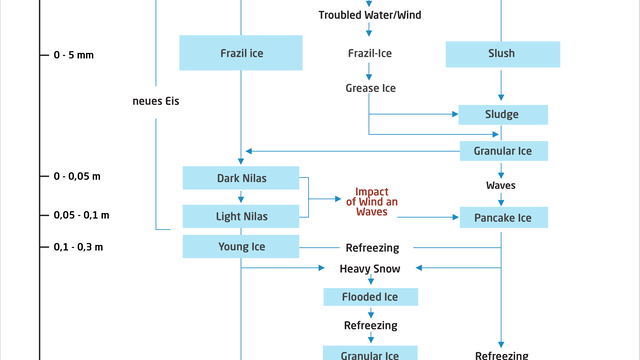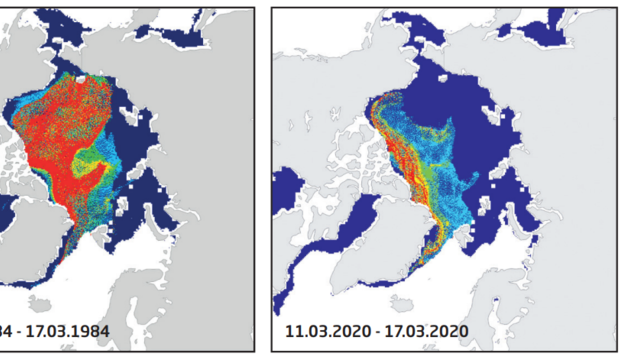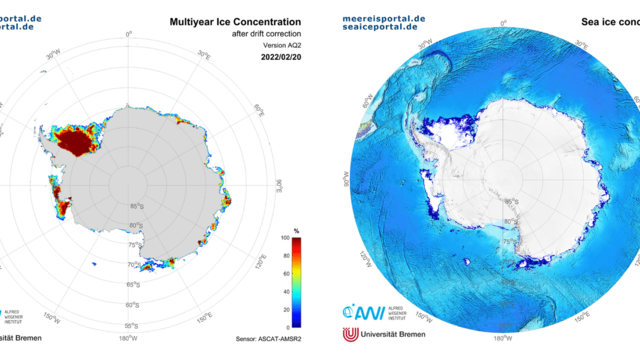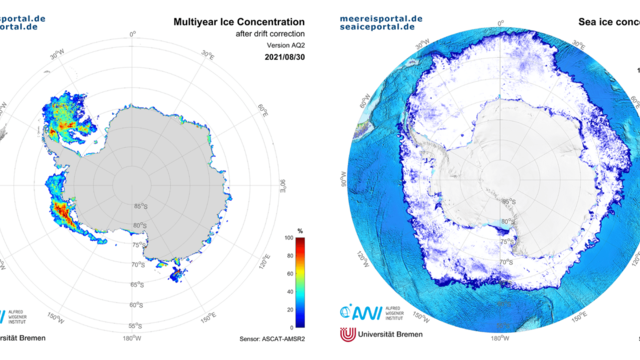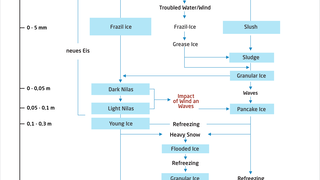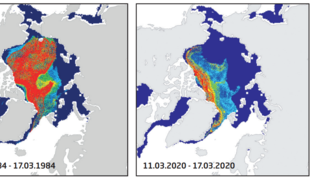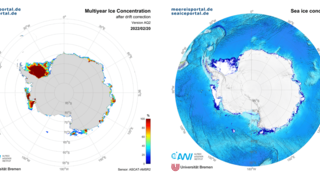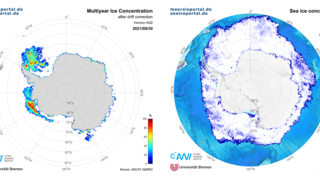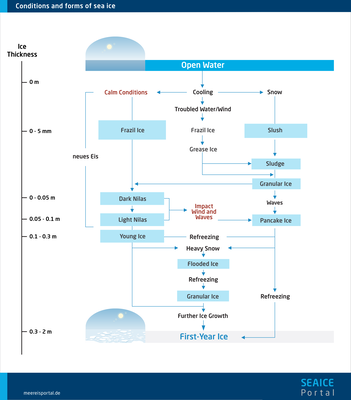In addition to ice extent and thickness, ice age is an important parameter for the characterisation and formation of sea ice! After all, as sea ice ages, physical characteristics like thickness, salinity and deformation – which are in turn important for the annual cycle, melting and drifting – also change. Moreover, a grasp of the different types of sea ice is essential for a range of applications, no matter whether navigating ships through ice-covered waters, modelling the ice/ocean/atmosphere system, or more generally remote sensing work involving other parameters connected to sea ice, e.g. the depth of snow cover on the ice. Given the accelerated loss of multiyear ice in the Arctic, the daily mapping of this type of ice has become more important for a number of applications.
When it comes to classifying sea ice, fundamentally speaking the following types are used:
- Young ice (YI): refers to newly formed ice, up to 30 cm thick. This category includes a number of subtypes, e.g. nilas and pancake ice (Fig. 1). Its surface can be smooth or rough.
- First-year ice (FYI): this type forms during the cold season (freezing season). With a thickness of more than 30 cm, its surface can be smooth, rough or furrowed.
- Multiyear ice (MYI): refers to ice that has already survived at least one summer (melting season). It contains less salt and is most often smoother than FYI.
Since 2019, the research group “Remote Sensing of Polar Regions” at the University of Bremen’s Institute of Environmental Physics (IUP) has focused on developing and implementing an algorithm for classifying ice types. The result: a map product that can detect “Multiyear Ice” in the Arctic and display it in the form of varying concentrations. This also allows patches of sea ice to be matched to age categories, and conclusions to be drawn regarding the dynamic development of the ice.
Dr Christian Melsheimer, a physicist at the IUP, has been working e.g. on an algorithm for classifying ice types for the past several years. “The MYI data was produced using a new, satellite-based method applied to the sea-ice types in the Arctic, which can essentially be divided into young ice (YI), first-year ice (FYI), and multiyear ice (MYI). This approach combines active and passive microwave data (radar scatterometer / radiometer). Originally developed for use in the Arctic, it has recently also been adapted for conditions in the Antarctic.” This was necessary, since the sea ice in the Antarctic is physically different from that in the Arctic. This aspect affects the ice’s microwave emissions and scattering, and therefore also the detection of multiyear ice.
Sea ice grows thicker, the colder the atmosphere is, as the air sucks more warmth from the ice and the water below it, accelerating the freezing process. But since thicker ice also insulates the ocean (protecting it from the cold), sea ice can only reach a few metres thickness through cooling alone. However, ice floating on the water is also subject to wind and ocean currents, which constantly move it (sea-ice drift). In the process, the ice can be deformed, i.e., compressed and stacked, which can substantially increase its thickness. The jagged structures formed, known as pressure ridges, can be up to ten metres thick. Multiyear ice is often affected by these dynamic processes, allowing it to reach thicknesses of several metres. Accordingly, the formation of sea ice involves various, at times simultaneous thermodynamic (cooling) and dynamic (drift, deformation) processes.
As Dr Melsheimer explains: “In the Antarctic, the conditions under which sea ice is formed and melts again are different from those in the Arctic, as the two polar regions are characterised by very different oceanographic and meteorological conditions.” Near the North Pole, the Arctic Ocean is surrounded by land masses, while the Antarctic is a polar continent surrounded by water. Accordingly, there are fundamentally different ocean currents and atmospheric patterns, which also affect ice formation. For example, the snow cover on the sea ice is most often thicker in the Antarctic than in the Arctic. In contrast, its thickness is usually lower in the Antarctic, since there is more heat input from the ocean than in the Arctic. In the Antarctic, the influence of wind and wave action from open water at the ice edge is more pronounced.
“The challenge in detecting multiyear ice is that, on the coast, the signal from the scatterometer or radiometer is distorted by the influence of the land, which leads to inaccurate MYI concentrations. Accordingly, for the first ten days of the season, the MYI in a zone measuring the width of the smallest imaging element (one pixel) is removed from the data along the entire coastline, unless it is connected to MYI off the coast,” Melsheimer explains. Given that no data can be gathered during the melting season (because the method can no longer differentiate between ice types when there is liquid water in the uppermost layer), the MYI data only covers the months of the freezing season: October to May for the Arctic, and February to October for the Antarctic.
Whereas in the Arctic, the amount of summer sea ice has been cut nearly in half since the 1980s and ice more than two years old only covers roughly a fifth of the region (Fig. 2), the sea-ice extent in the Antarctic at the end of the freezing season has remained virtually unchanged since the beginning of satellite observation; in fact, it has increased by 0.5% per decade. However, since 2014 there have been unprecedentedly strong fluctuations. In contrast to the Arctic, roughly two thirds of the sea ice in the Antarctic melts in the course of the year; as a result, in comparison to the maximum sea-ice extent at the end of winter, very little MYI survives.
Figure 3 (left) shows the concentration map of multiyear ice for 20 February 2022, the first day in the 2022 freezing season with an available dataset. The data is now updated on a daily basis and can be accessed here. As can be clearly seen, the largest area of multiyear ice is in the southwest Weddell Sea. This region at the foot of the Antarctic Peninsula normally survives the melting phase each year, which is why it’s home to ice thicknesses of up to several metres. A further area of multiyear ice can be found in the Bellingshausen and Amundsen Seas. For comparison, the sea-ice extent on the same day is shown in Figure 3 (right). Nearly all the remaining ice is MYI.
Since we are now in the middle of this year’s freezing season, which will most likely continue through the end of October, the map of MYI at maximum sea-ice extent in the Antarctic on 30 August 2021 (Fig. 4, left) is also included. While a massive belt of pack ice surrounds the Antarctic, drifting has transported the multiyear ice to the northwest Weddell Sea and significantly reduced its concentration. The majority of the Antarctic pack-ice belt consists of first-year ice. Multiyear ice drifts with the general circulation, which is itself divided by winds and ocean currents, and can no longer be detected on a large scale by the algorithm. This becomes clear from the lower ice concentration and simultaneous larger area covered. Generally speaking, the update of the MYI product and its expansion to include the Antarctic will be extremely helpful for potential shipping, and for other branches of science, e.g. those focusing on the habitat and ecosystem of the Arctic and Antarctic sea ice.
You can access the new data product here.
You can find additional information on sea-ice formation at:
www.meereisportal.de/meereiswissen/was-ist-meereis/entstehung-von-meereis/wachstum-von-meereis/
https://seaice.uni-bremen.de/multiyear-ice-concentration/
Contacts
- Dr. Christian Melsheimer (IUP)
- Dr. Renate Treffeisen (AWI)
- Dr. Klaus Grosfeld (AWI)
- Dr. Annekathrin Jäkel (AWI)
- Dr. Nadine Wieters (AWI)
Questions?
Contact us via E-Mail or our contact form.
Graphics
